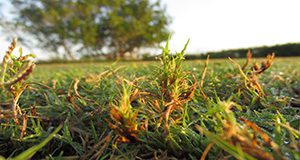The bermudagrass mite, Eriophyes cynodoniensis (Sayed) (Arthropoda: Arachnida: Eriophyidae), also known as the couch grass mite, can be a serious pest of bermudagrass in multiple high-maintenance turf systems such as sod production, athletic fields, and golf courses. Mites cause leaf and bud galls, which can lead to severe aesthetic damage and plant decline or death in high-maintenance areas with low tolerance for plant damage. In this 7-page fact sheet written by Pablo Agustin Boeri, Nicole D. Benda, J. Bryan Unruh, and Adam Dale and published by the UF/IFAs Entomology and Nematology Department, review the biology, identification, and management of the bermudagrass mite, and get specific management recommendations based on evidence from UF/IFAS research.
https://edis.ifas.ufl.edu/in1217
Tag: J. Bryan Unruh
Minimizing Traffic Damage to Your Florida Lawn (ENH152/EP071)
 Excess vehicular or foot traffic causes multiple injuries to turfgrass, but there are specific management and maintenance practices that will improve the wear tolerance of your turfgrass. This 2-page fact sheet was written by L. E. Trenholm and J. B. Unruh, and published by the UF Department of Environmental Horticulture, August 2011. (Photo by Milt Putnam)
Excess vehicular or foot traffic causes multiple injuries to turfgrass, but there are specific management and maintenance practices that will improve the wear tolerance of your turfgrass. This 2-page fact sheet was written by L. E. Trenholm and J. B. Unruh, and published by the UF Department of Environmental Horticulture, August 2011. (Photo by Milt Putnam)
http://edis.ifas.ufl.edu/ep071
Zoysiagrass for Florida Lawns (ENH11/LH011)
Zoysiagrass maintenance is different from that of other Florida lawn grasses. When improper maintenance practices are followed, undesirable results are likely to occur. Learn the details about this attractive turfgrass that has been dramatically improved by turfgrass breeders in recent years. This 8-page fact sheet was written by J. Bryan Unruh, L. E. Trenholm, and J. L. Cisar, and published by the UF Department of Environmental Horticulture, June 2011.
http://edis.ifas.ufl.edu/lh011
Centipedegrass for Florida Lawns (ENH8/LH009)
Centipedegrass is a slow-growing grass with low fertility requirements when compared to other Florida lawn grasses. It grows close to the ground, is medium textured, and is naturally lighter in color than other lawn grasses. Well-adapted to the climate and soils of Central and Northern Florida, it is the most common home lawn grass in the Florida Panhandle. There is now one cultivar adapted to South Florida conditions. This 7-page fact sheet discusses the advantages and disadvantages of this turfgrass variety, cultivars available for lawn use in Florida, establishment, maintenance, pest management, and other problems. Written by J. B. Unruh, L. E. Trenholm, and J. L. Cisar, and published by the UF Department of Environmental Horticulture, April 2011.
http://edis.ifas.ufl.edu/lh009
St. Augustinegrass for Florida Lawns (ENH5/LH010)
St. Augustinegrass is widely adapted to the warm, humid (subtropical) regions of the world. It is the most commonly used lawn grass throughout the state of Florida and can grow satisfactorily in a wide variety of soils. This revised 11-page fact sheet discusses the advantages and disadvantages of this turfgrass variety, cultivars available for lawn use in Florida, establishment, maintenance, pest management, and other problems. Written by L. E. Trenholm, J. L. Cisar, and J. B. Unruh, and published by the UF Department of Environmental Horticulture, April 2011.
http://edis.ifas.ufl.edu/lh010
Bahiagrass for Florida Lawns (ENH6/LH006)
Bahiagrass is a popular, low-maintenance lawn grass that does well with limited water and fertilizer inputs. Although bahiagrass does not produce a carpet-like, dense lawn like some other warm-season lawn grasses, it does provide a good, low-maintenance lawn where slightly reduced visual quality is acceptable. This revised 7-page fact sheet was written by L. E. Trenholm, J. L. Cisar, and J. B. Unruh, and published by the UF Department of Environmental Horticulture,April 2011.
http://edis.ifas.ufl.edu/lh006
Bermudagrass for Florida Lawns (ENH19/LH007)
Bermudagrasses (Cynodon spp.) are among the most widely used warm-season grasses. Improved, fine-textured bermudagrasses are used throughout the south on golf courses, athletic fields, and in high-profile residential and commercial landscapes where a fine-textured, dense ground cover is desired. This revised 5-page fact sheet describes advantages, disadvantages, cultivars, maintenance, and pest problems. Written by L. E. Trenholm, J. L. Cisar, J. B. Unruh, and published by the UF Department of Environmental Horticulture, March 2011.
http://edis.ifas.ufl.edu/lh007
